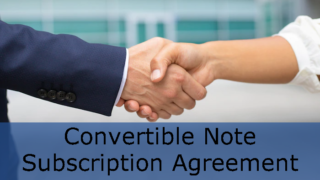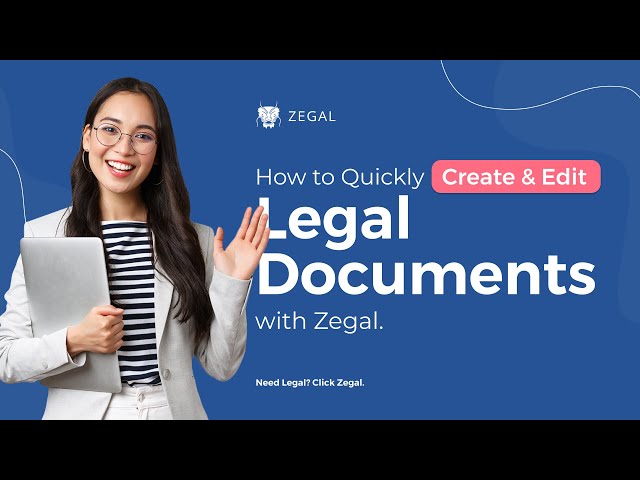How to generate a Convertible Note Subscription Agreement
What is a Convertible Note Subscription Agreement?

A Convertible Note Subscription Agreement is a contract for an investor to subscribe to a convertible note, which is a debt instrument that converts into equity under predefined conditions.
The conditions for a convertible note to convert into equity under a Convertible Note Subscription Agreement are qualified financing, at a liquidity event, or on the maturity date.
To raise funds by issuing convertible notes, either a Convertible Note Subscription Agreement or a Convertible Note Instrument can be used. If a company has one (or very few) investors subscribing for the note, a Convertible Note Subscription Agreement may be used.
Contrary to a Simple Agreement for Future Equity (SAFE), a convertible note created under a Convertible Note Subscription Agreement is interest-bearing, has a maturity date, and specifies a minimum amount of funds to be raised at the equity financing.
Guidance
- Qualified financing (i.e., subsequent fundraising by the company which exceeds a certain minimum amount): the note will be converted into the same class of equity issued by the company at the qualified financing (typically preferred shares with additional rights compared to common equity);
- A liquidity event (i.e., a change of control or listing): the note will be converted into ordinary shares right before the liquidity event; or
- If neither of the above happens, on the maturity date (i.e., the due date of the debt): the note will be converted into shares, typically ordinary shares.
- A discount to the fully diluted price per share – compared with the price paid by investors in the qualified financing or the reference price for the liquidity event; and
- A cap on the fully diluted price per share at which the conversion will occur. In the documentation you will find in the Zegal app, this cap is expressed as a cap to the post-discount pre-money valuation at the conversion event.
Key terms explained
“Qualified financing” is the minimum size of fundraising to be achieved by the company which will trigger conversion. This represents a sufficiently large amount of funding that signifies the growth of the company to a stage where the investor is happy to become an equity holder instead of a creditor.
“Valuation Cap”, also known as “price cap” or “conversion cap”, is the ceiling for the conversion price. This figure serves as the limit on the conversion price rather than a genuine valuation, which is often not possible at an early stage of a business with too little record and data available. The valuation cap price is arrived at by dividing the valuation cap by the number of outstanding shares at the relevant time.
“Discount rate” is the percentage discount to be applied in determining the conversion price. You should note that only the lower valuation cap price and the discounted price will apply.
“Maturity date”. The duration of a convertible note can vary widely – for example, 6 months for a bridge financing to a Series A financing to a much longer timeframe (e.g., 5 years). The duration will have an impact on which type of investors can invest in the note – for example, some funds have a mandate not to invest in debt-like instruments with a duration beyond 12 months. On the other hand, angel investors do not have such restrictions.
“Pro-rata right” is the right for the investor to participate in the qualified financing (i.e. buying additional equity with additional cash upon the terms of the qualified financing), up to an amount that when taken together with the equity converted from the convertible notes, will result in the investor maintaining the same percentage of ownership in the company.
Pro-rata right is often very important to more sophisticated seed investors because it gives them the right to follow on with their most successful investments and to potentially ‘protect’ their ownership stake during a potential down-round (round conducted at a lower valuation than the previous round). However, it could also mean reduced flexibility in negotiating with investors at subsequent rounds and can lead to renegotiation of these rights with earlier investors to facilitate the next round. This clause is offered as an option in the Convertible Note Instrument (if this right will be granted to all investors) or in the Convertible Note Subscription Letter (if you want to keep the flexibility to grant this right only to specific investors – for example depending on their level of investment).
“Dividend payments”. Investors in a convertible note are not shareholders and will not have the right to potential dividends paid out before conversion. They will typically request that no dividend is paid out prior to conversion to make sure their investment goes to growing the company and not to paying existing shareholders. This clause is offered as an option in the Convertible Note Instrument you can create in the Zegal app, by which you can stipulate that the company will not pay any dividend until the convertible note is converted.
Steps to create a convertible note and get investors to invest
Step 1: Initial negotiation
You may create a Convertible Note Term Sheet to facilitate discussion with your investors. A term sheet is a simple and easy-to-read document, which is not legally binding.
Step 2: Creation of the convertible note
Step 2: Creation of the convertible note
Create a Convertible Note Instrument on the Zegal app. The creation of convertible notes requires approval at both the board and shareholders’ levels. Instruct your company secretary to prepare the relevant minutes or written resolutions to record such approval, or contact us for assistance.
Execute the Convertible Note Instrument as a deed. Always check your Articles of Association for the requirement to validly execute a deed, or consult your company secretary.
Step 3: Subscription by investors
Create the Convertible Note Subscription Letter for each investor to evidence which amount of convertible note he will subscribe to and how he will pay. Each investor will execute a separate letter. This letter needs to be countersigned by the company to confirm acceptance.
Step 4: Completion of subscription
Step 4: Completion of subscription
Upon the investor paying the principal amount to the company, the company will issue a Convertible Note Certificate to the investor. This certificate also needs to be executed as a deed.
Convertible Note vs Advanced Subscription Agreement
The most prominent difference between these two is the interest rate and tax. The ASA has no interest rate applied and the repayment does not have to be within a specific time. Next, when the Convertible Note Document is used, investors are not eligible for SEIS/EIS tax treatment but when ASA is used they can obtain SEIS/EIS relief.
Why is a CONVERTIBLE NOTE AGREEMENT important for a company?
A convertible note agreement is an important document for a company because the terms and conditions of the final legal agreement are based on this initial agreed-upon document. A convertible note subscription letter is given to each investor as proof that defines the amount of convertible note the investor will subscribe to and pay. This letter also demands to be countersigned by the organization to confirm acceptance.
Additional information
Alternatively, if you have only one (or very few) investor(s), you may use a Convertible Note Subscription Agreement. This document combines a Convertible Note Instrument and Convertible Note Subscription Letter but requires a slightly different approval and signing procedure. If you wish to use this approach, please contact us.
There are numerous ways to construct a convertible note. You may agree with your investors that a different conversion pricing mechanism will apply, or in certain events, the investor will get money back instead of equity. If you wish to create convertible notes of different mechanisms, contact us.
Conclusion
Convertible notes subscription agreement provides companies with a means to get a capital investment that may be later converted into shares, instead of being paid back in cash. It is a great alternative way to go ahead and shape the financing round for companies.
Key points included
- Principal amount to be subscribed by the investor;
- Interest rate;
- Maturity date;
- Discount rate;
- Valuation cap;
- Qualified financing amount;
- Additional optional clauses such as restrictions on dividend payments prior to conversion or pro rata rights; and
- Nature of shares into which the note converts depending on the conversion event.
You Might Also Like
Along with this document, make sure you see these other templates in our library:
Stay compliant with the Zegal template library
Zegal legal template are meticulously crafted with the precision of AI and the expertise of seasoned human lawyers, providing a unique blend of speed and reliability.
You can trust that Zegal agreements are legally sound and fully compliant with current regulations.
Whether you're a startup, SME, or a larger enterprise, Zegal contract management will automate and speed up your legal processes.
Using Zegal will reduce risk, save money, and improve efficiency. Let us take care of the paperwork so you can focus on running your business.
Don’t compromise on speed or compliance. Stay secure, compliant, and efficient with Zegal.






